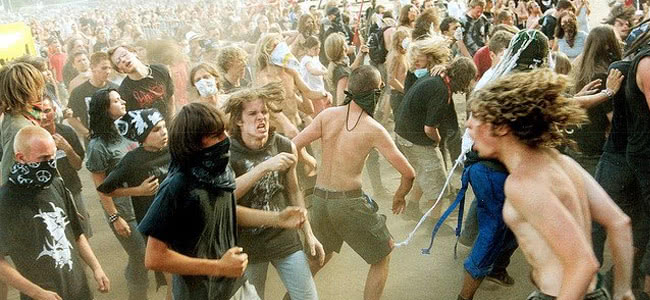With the hard and heavy Soundwave Festival kicking off next Saturday 23rd February at Brisbane’s RNA Showgrounds (set times here), there’s bound to be punters rubbing their hands at the prospect of a good ol’ mosh pit.
But have you ever been amongst a raging mosh pit and stop to think and wonder about how physics and the science behind collective behaviour applies to a mosh?
No? Well, we haven’t either, but as The Atlantic reports, a young graduate of New York’s Cornell University’s physics department did and based an entire research project on it.
Though the mosh can often be dismissed as a chaotic field of out-of-control madness, the Cornell student Jesse Silverberg has found that there are distinct reoccourances in a mosh environment that suggest a sort of organised chaos as opposed to a state of pure anarchy.
Silverberg, who is a self described ‘moshing physicist’, says that he first started to notice certain patterns to the behaviours involved in moshing when he first took a step back and observed from an outsiders’ perspective.
Silverberg says “being on the outside for the first time, I was absolutely amazed at what I saw – there were all sorts of collective behaviors emerging that I never would have noticed from the inside.” His research extended into the realm of YouTube to try and gain a better insight into what happens to people when exposed to “loud, fast music (130 dB, 350 beats per minute)… bright, flashing lights, and frequent intoxication.”“It turns out that the statistical description we use for gasses matches the behavior of people in mosh pits” – Jesse Silverberg, Moshing Physicist
His findings concluded that the “collective phenomenon consisting of 10^1 to 10^2 participants commonly referred to as a mosh pit,” was often based on a series of collective behavioural patterns. Including the ‘wall of death’, which Silverberg describes as when “moshers split into two groups separated by an open space and, when signaled, simultaneously run at the opposing group.”
Silverberg then proceeded to “simplify the complex behavioral dynamics of each human mosher to that of a simple soft-bodied particle” and created an interactive program in which parameters such as ‘noise strength’ and ‘speed’ can be adjusted to alter the behaviour of the humans and moshers, representing by coloured dots.
In the model Silverberg likens moshers to randomly colliding gas particles and finds that the principles often associated with studying these particles can also be applied when studying the physics of a mosh pit. “It turns out that the statistical description we use for gasses matches the behavior of people in mosh pits. In other words, people bounce around like the molecules in a gas,” says Silverberg.
Silverberg and his team also found that their research could be applied to instances where similar conditions took place amongst large crowds of people, such as that of a riot or a large scale emergency, and could in fact be used to help improve conditions in these circumstances.
So next time you’re out and about to participate in a wall of death or about to stage dive into a sea of fast-paced punters, stop and think about what kind of collective behaviours could be going on. Or maybe save it for after the gig.
You can have a play with the interactive model over at Silverberg’s research page. (Pretty cool, hey?)

































